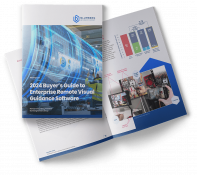Help Lightning Blog
On The Job Training: Tips to Optimize Onboarding

Employee onboarding is the key to ensuring efficiency and quality. This way, new hires can achieve the greatest success in their position as soon as possible. The time it takes to onboard an employee is greatly impacted by whether or not they are able to get on the job training. As is commonly said, the best way to learn is by doing and making mistakes.
One of the challenges of this style of onboarding is that it typically requires extensive oversight from both human resources and long-term employees. But with advanced technology like remote assistance software, it’s easier than ever to get new hires up to speed and productive.
Augmented reality is the core of remote visual assistance. It provides higher-level video collaboration facilitated by a simple and affordable piece of technology like a tablet. With this tool, new hires and seasoned employees can work virtually side-by-side as needed regardless of their physical location. Keep reading for high-level tips to optimize employee onboarding time with remote assistance software.
Next Level On The Job Training With Remote Visual Assistance
Getting an employee used to their new position is a monumental task that shouldn’t be underestimated. There are the social elements of getting them familiar with the company culture. It also helps them become comfortable with their fellow employees or upper management. Then there’s the challenge of setting them up with all of the technology, software, and various workflow interfaces used to maintain accountability. Something as simple as clocking in or where to find the bathrooms can require focused preparation by the onboarding team.
Every company’s HR department has its own system for streamlining the onboarding process. But things get much trickier when on-the-job training is the primary aim. Not only is the transition from basic training to actual work with consequences a situation ripe with the possibility for errors. It’s also difficult to prevent other trained employees from feeling overwhelmed with mentorship.
Time Optimization And Personnel Management Are Essential
With remote assistance software, new hires can essentially have their mentor in their pocket and only utilize them when absolutely necessary. For example, consider an employee in a field where they need to meet clients away from main headquarters. But, in this case, their supervisor needs to be in critical in-person meetings most of the day.
Instead of requiring a complete adjustment to everyone’s schedules so that the supervisor can monitor the new employee’s progress all day? The new employee can have the option of accessing remote assistance when necessary. If they aren’t entirely sure how to proceed with a solution or project they are conducting, they can request help from the supervisor, who doesn’t need to be physically present. With features like 3D annotations and merging of the video streams, the more senior employee can carefully guide the trainee as if they were together.
For this reason, remote visual assistance opens up a wide range of possibilities for on the job training. It’s much easier to promote the optimal use of everyone’s time if assistance is targeted and virtual.
On The Job Training Should Provide Easy, Enjoyable, and Long-Term Support
The truth is that no one likes sitting at a computer all day in lectures or going through training modules. People who love what they do want to get in the midst of their new job as soon as possible. By allowing new hires to spend more time learning the ropes of their job as they go, they’ll have the opportunity to be even better at what they do. They can also recognize knowledge gaps sooner rather than later, and integrate into their new team much quicker.
Remote visual assistance provides the missing piece to an efficient onboarding program. Plus, we know more employees are spending significant chunks of the week working from home. Now there will be less need to disrupt those employees, forcing them to change their usual environment for training purposes.
This is even more applicable to organizations whose employees are primarily remote or work in highly skilled technical careers. In both cases, on-the-job training is not optional. The process is far smoother and easier to set up when there are resources like augmented reality to fill in any gaps. Plus, there’s an added benefit. Your new employees will feel the support and experience greater job satisfaction. All by knowing that they can access assistance whenever they are stuck or confused. They won’t feel the looming presence of someone watching for every small mistake. But they’ll know they can ask for help if they deem it useful.
Taking The Next Step
Get the full scoop on how remote visual assistance from Help Lightning can support your onboarding procedure. Request a free demo today.












